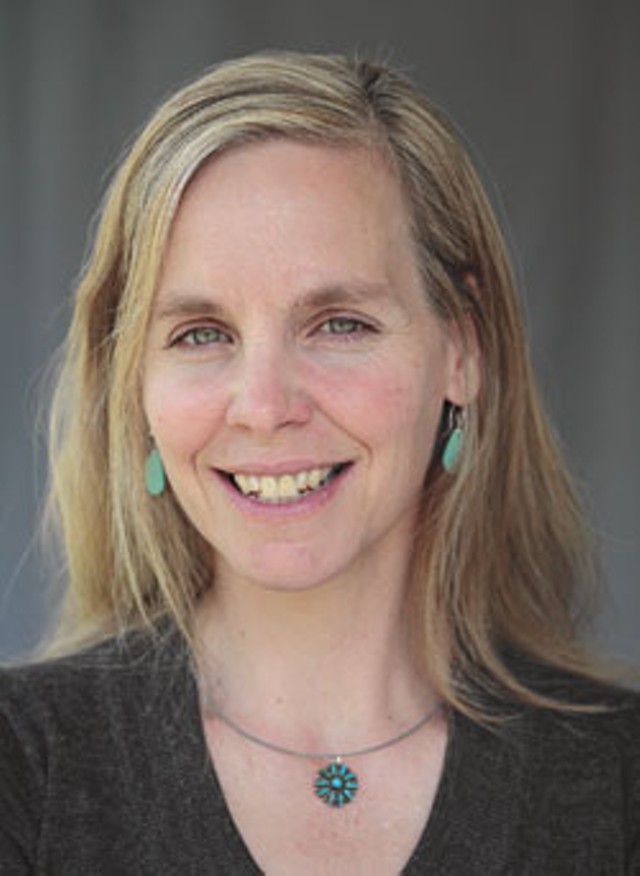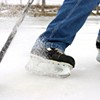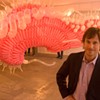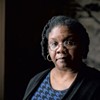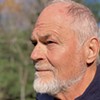Published April 8, 2009 at 8:33 a.m.
Amy Seidl wants to grow peaches, but she knows she would eat them with mixed feelings. Global warming is raising average temperatures in her Huntington hollow, and thriving peach trees would presage the fall of her beloved sugar maples.
That subtle observation is one of the keenest in Seidl’s debut book, Early Spring: An Ecologist and Her Children Wake to a Warming World. Rather than detailing the logistics of climate change — in case you haven’t heard, unprecedented levels of atmospheric carbon dioxide are throwing the planet out of whack — Seidl chronicles both the signs of the phenomenon and our perception of them. In other words, her pastoral vignettes show how a complex scientific process affects people both physically and emotionally.
Don’t assume Early Spring skimps on hard science. A well-traveled biologist who has taught at the University of Vermont and Middlebury College, 45-year-old Seidl packs seven chapters with fascinating data about animals, watersheds, forests and weather patterns. Some of her notes about alpine butterflies draw on research she conducted in the Rocky Mountains. Her footnotes abound in citations from Nature, Ecological Monographs and Bulletin of the American Meteorological Society. And her descriptions of the Vermont landscape draw on The Old Farmer’s Almanac and local newspapers.
Consider Seidl’s chapter on “Weather,” in which a historical anecdote illuminates a broader narrative. Back in the summer of 1816, Seidl writes, a surprise frost forced Vermont farmers to import corn from the Carolinas. That precedent lends urgency to her question: “How will we react in the twenty-first century to weather that has gone amok and sends us backward in time or skips seasons altogether? How will we react when the familiar markers of our home places fade away?”
“Familiar markers” make Early Spring accessible to readers — and critics — who can’t operate Bunsen burners. At one point, for instance, Seidl ponders the lilac bushes outside her kitchen window and notes that the flowers are blooming eight to 16 days earlier than they were when she was born. By the time her daughters are grown, she fears, the same flowers could be blooming a month prematurely.
“Will the changes brought on by global warming be predictive increases, linear like lilac blooming, that we can anticipate?” Seidl asks. She answers her own question on an ominous note: “It is unlikely. It is more likely that they will be chaotic because the changes themselves will trigger other, less-well-predicted responses in a series of feedback loops.”
Seidl’s landscape is populated with people who note the early signs of change with apprehension. When she stops at a Huntington general store for groceries, fellow customers discuss the weather, Greek-chorus style. Bob Low, a “self-appointed warden of a landscape,” keeps a journal about a local pond that helps Seidl illustrate how global warming affects freezing points. When Seidl’s young daughter Celia prepares to taste freshly boiled sap in a sugarhouse, her mom wonders, “How will we let this ritual go?” The question links scientific problems to philosophical ones.
The style of Early Spring nods at Gilbert White, Henry David Thoreau, Aldo Leopold and Rachel Carson — naturalists who chronicled how the physical world relates to human experience. The book isn’t as lyrical as Thoreau’s Walden, or such contemporary classics as Annie Dillard’s Pilgrim at Tinker Creek or Bill McKibben’s The End of Nature, a 1989 treatise on climate change the Ripton author wrote while living in the Adirondacks. But Seidl has a nose for meter and metaphor. “The cream on top is two inches thick and a pale yellow, the color of climbing roses,” she writes of a milk pail. “I skim it off and set it aside for coffee.”
Like McKibben, who now oversees a global campaign aimed at crafting sensible climate policy, Seidl is a seasoned environmental activist. Her poetic observations, not surprisingly, are tempered by reminders that global warming spells trouble. In one chapter, a Franklin County farmer mitigates CO2 pollution by building topsoil. In another, Seidl’s Huntington neighbor milks a cow as a way of addressing what Seidl terms a “quandary of how best to live lightly.” The author does her part by planting rye outside her house.
“Will planting rye in the shoulder seasons be enough to make a difference?” Seidl reflects in one of her Socratic inner dialogues. “Certainly not, but it’s a gesture, a way to frame the question and provide a benchmark to judge the extent of my own complicity.”
Hard-core environmentalists might dismiss Seidl’s “gesture” as just that. But the author harbors no illusions that quick fixes will save our landscapes from irreversible change. While her dialogues with herself provide no large-scale solutions, and sometimes feel clunky, they’re a perfect medium for her ambivalence — her sense of her “complicity” in global warming, as she puts it. Those human insights are what makes Early Spring such an engaging read.
Indeed, as Seidl poses questions while romping along trails and across forests and alpine meadows, we begin to appreciate her ambivalence. Too often, scientific terminology about global warming — think “parts per million” and “cap-and-trade” — distracts lay readers from considering how the phenomenon affects their daily routines. Watching an expert like Seidl contemplate the futility of her rye harvest puts a face on the jargon.
That’s not to say jargon doesn’t matter. Without it, the world leaders who will convene in Copenhagen this fall wouldn’t have a hope of drafting a new global climate policy in a last-ditch effort to reduce concentrates of atmospheric CO2 below 350 parts per million. Literature matters, too, however. As Bill McKibben notes in his forward to Early Spring, Amy Seidl employs the most “sensitive” scientific instrument of all: the heart.
From Early Spring
Truly avid ice fisherman wait all fall for the lakes to freeze. Icefishing is a New England tradition they’ve counted on for more than a century. A fishing shack shaped like an outhouse with a stovepipe coming out at an angle is a familiar sight on Vermont’s ponds and lakes in winter. So too are the holes drilled into the ice, with lines known as jiggers extending from them that are tied to silver lures and baited with something “sweet” like a minnow. You know a fish is on a line when a tipped-up orange flag signals there’s weight on a hook, and the fishermen come running from their shack to see about their catch. Gillett Pond is scattered with these holes after the ice fishermen have gone. I skate around them and look down. If I’m lucky I see a trace of the life below, an eye surfacing or the twitch of a tail.
In late February there is a scheduled fishing derby on Lake Champlain, one that’s been held for decades. Families haul their shacks by trailer to the ice and carry out gear and essentials for a weekend of fishing. But lately it is cancelled more times than it is run. They can’t depend on the ice, can’t depend on it to hold up. Curiously this is what Arctic people say about their own travel on the ice: It doesn’t hold up — to the weight of their snow machines, their boats, or their packed sleds of fish and marine mammals.
In Brookfield, Vermont, it’s ice harvesting that gets people out on the ice. Since 1975 Brookfield has celebrated midwinter by harvesting chunks of ice from Sunset Lake and holding a festival. In the early days, draft horses carried the ice across the lake to the spectators reliving the tradition that refrigeration has replaced. Now it’s trucks and ATVs that carry the ice back to the people on the shore. People like Al Wilder, who has been a part of the ice harvest for twenty-nine years. Al reports that ice thickness fluctuates year to year, from twenty-five to thirteen inches. Sometimes there’s no ice at all, like in 2007, when the festival was called off. “It’s definitely getting thinner,” he tells me two weeks before the festival. “There hasn’t been ice strong enough to walk on in November since 1977, and I haven’t skated on it in early winter since the ’80s.”
Like the loss of pond hockey at Christmas or the cancellation of an annual Nordic ski race, ice fishing and ice harvesting are rituals that are waning with warming. As cultural rituals in a northern state, they were once relied upon, and then they started to come and go. In time they may be gone altogether.
Want to learn more?
Early Spring: An Ecologist and Her Children Wake to a Warming World by Amy Seidl. Beacon Press, 172 pages. $24.95.
Amy Seidl reads from Early Spring on April 14 at The Flying Pig Bookstore in Shelburne at 7 p.m.; on April 15 at Alliot Student Center, St. Michael’s College, at noon; and on April 16 at Hillcrest Building, Middlebury College, at noon. For details, click here.
More By This Author
Speaking of...
-

Vermont Senate Advances Bill to Make Big Oil Pay for Climate Crisis
Apr 2, 2024 -

Court Upholds Vermont Gas' Purchase of Methane From a New York Landfill
Jan 12, 2024 -

Key Vote on Burlington District Energy Project Looms on Monday
Nov 17, 2023 -

UVM Scientists Unearth Bad News for Our Climate Future Beneath the Greenland Ice Sheet
Oct 11, 2023 -

Green Mountain Power Aims to Eliminate Outages by 2030
Oct 10, 2023 - More »
Comments
Comments are closed.
From 2014-2020, Seven Days allowed readers to comment on all stories posted on our website. While we've appreciated the suggestions and insights, right now Seven Days is prioritizing our core mission — producing high-quality, responsible local journalism — over moderating online debates between readers.
To criticize, correct or praise our reporting, please send us a letter to the editor or send us a tip. We’ll check it out and report the results.
Online comments may return when we have better tech tools for managing them. Thanks for reading.



































